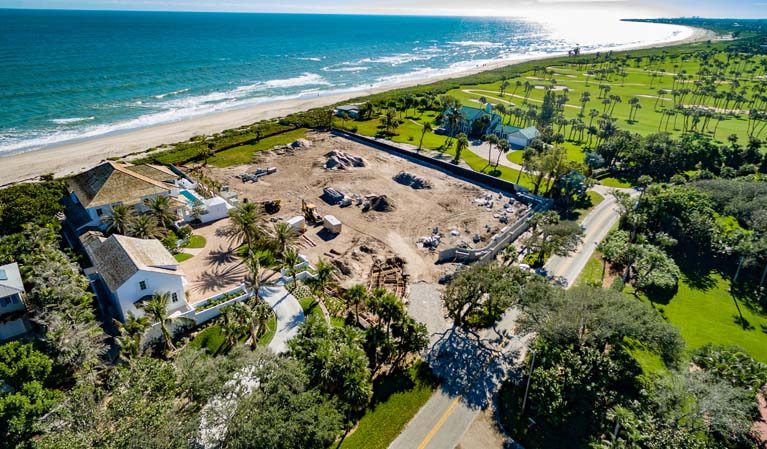
Site work is underway for a magnificent home on the ocean, two lots north of the Riomar Country Club Golf Course, which knowledgeable realtors say will be the largest house in Old Riomar.
The island’s most venerable neighborhood, Riomar came of age in the 1920s when Addison Mizner was transforming Palm Beach, and many of the original homes along Riomar’s oak canopied lanes were built in the romantic Mediterranean Revival style he perfected.
Members of the 98-year-old Riomar Country Club and other residents are deeply attached to the neighborhood’s narrow shell roads and sleepy ambiance, and word on the street is some of the old guard are not too enthused about a 17,400-square-foot home with two swimming pools and three guest houses going up in the coming year.
But the house at 2310 Ocean Drive – which upon completion will be worth $15 million to $20 million – is no McMansion. Looking more British West Indies than anything else on the plans drawn by Melbourne architect Jackson Kirschner, it is nicely sited on the 74,500-square-foot lot, leaving 56 percent of the property as open space.
The home will disappear behind a landscape buffer after a year or so, and be little noticed. And it is not an outlier. Nearby lots have been redeveloped in recent years, with big houses replacing smaller ones. The modernist house at the other end Ocean Drive is larger than the one going up in Riomar, and there are homes of similar stature up and down the 32963 shoreline.
Matilde Sorensen, the real estate broker who both listed and sold the Riomar property, says that the buyers – a young family with seven children – are outstanding people who will be a substantial addition to the community.
The value of oceanfront land on the island, and the caliber of new residents attracted to ZIP code 32963 at this stage in its evolution, practically guarantee that homes on this scale will become more and more common – adding to the reputation (and tax base) of Vero Beach.
The original house on the lot at 2310 Ocean Drive was built in 1946, when most of the island was still undeveloped and property was cheap. In 1991, Richard Dillion and his wife Phyllis bought the home and land for $1.2 million, living there until the property was sold in May 2016.
The property was not on the market when Sorensen brought the buyer and the Dillons together.
Richard Dillon, who passed away in August, was described in his Princeton Alumni Weekly obituary as “a pioneering advertising executive and entrepreneur . . . who co-created one of the first advertising agencies focused on marketing to Hispanics in the United States.” Phyllis Dillon still lives in Vero Beach.
Oceanfront land sales are categorized by price per linear foot, and the lot at 2310 extends for 203 feet along the Atlantic Ocean, which means the buyer paid nearly $44,000 a foot for the prime Central Beach property close to the art museum and theater, Quail Valley club and all the oceanside restaurants and shops. The price, $8.875 million, was not a record but approaches the highest prices paid for oceanfront land on the island during the peak of the real estate boom in the mid-2000s.
After the sale, the post-war house was torn down and plans for the new compound were developed. The county issued a building permit in November and site work began shortly afterward.
A heavy retaining wall is being built around the perimeter of the property to contain more than 7,000 cubic yards of fill that will be brought in to raise the grade 7-8 feet, putting the floor of the main house 19 feet above sea level. (In case anyone is worried about runoff, there will be underground storm-water retention chambers.)
The main house, three guest houses, two 30-foot by 34-foot garages and other structures will be built on a foundation of hundreds of 16-inch diameter auger pilings loaded with steel rebar that will go down 40 feet or so to marl, and be tied into a matrix of heavy concrete grade beams to make the house a permanent part of the landscape.
The main house will be two stories, 35-feet high, with an open first-floor interior that includes a 36-foot by 48-foot central space (foyer, great room and gallery) and another vast kitchen/family room combination.
Also on the first floor are an elaborate master suite, a media room, a 30-foot by 30-foot game room and two full-featured attached guest houses. A third guest house stands apart, behind the twin garages.
Two staircases and an elevator connect the first floor to the second where there is another, even more awesome master suite, along with four 19-foot by 19-foot guest or child bedrooms with private baths and balconies.
Almost the entire ocean-facing back of the house will be glass, a shimmering series of glazed French, bi-fold and pocket doors.
The oceanfront pool, set in an expansive terrace, is 16-foot by 41-foot. When it is too windy on the oceanfront, swimmers can chose a second similar-sized pool on the sunny south side that is in a sheltered courtyard between the game room and attached guest houses.
The way the property lays out around a series of four main courtyards and terraces is one of its most attractive and interactive features.
Even as colorless lines on paper, without the benefit of the all the tones and textures of the “best quality” finish materials specified on the plans, a tangible quality of spatial excitement and aesthetic intrigue radiates from the envisioned structure.
This a place where it will be an adventure to live – a place that will become an impressive feature of a community residents regard as Vero’s premier neighborhood.
Besides Jackson Kirschner, Architects, the design build team includes Mills Group, landscape architect; Schulke, Bittle & Stoddard, structural and civil engineers; Kamm Consulting, mechanical and electrical engineers; and the Hill Group, builder and general contractor.



